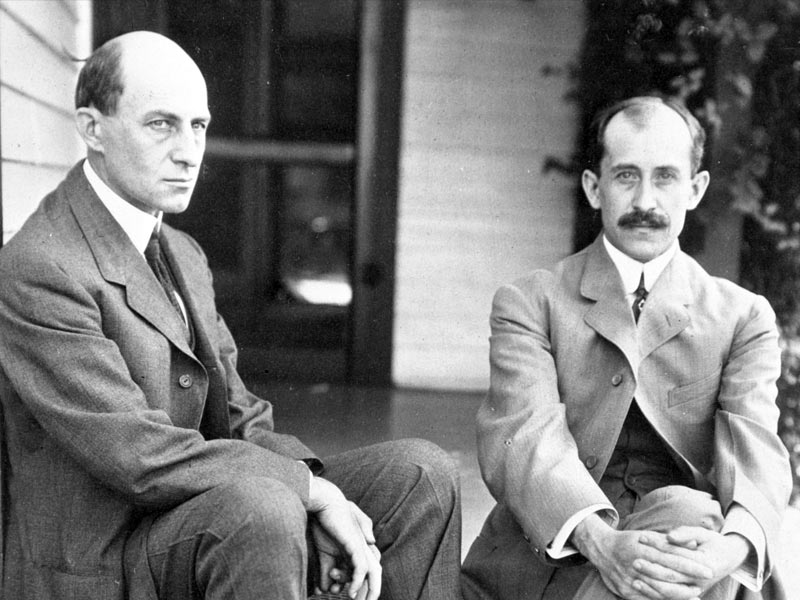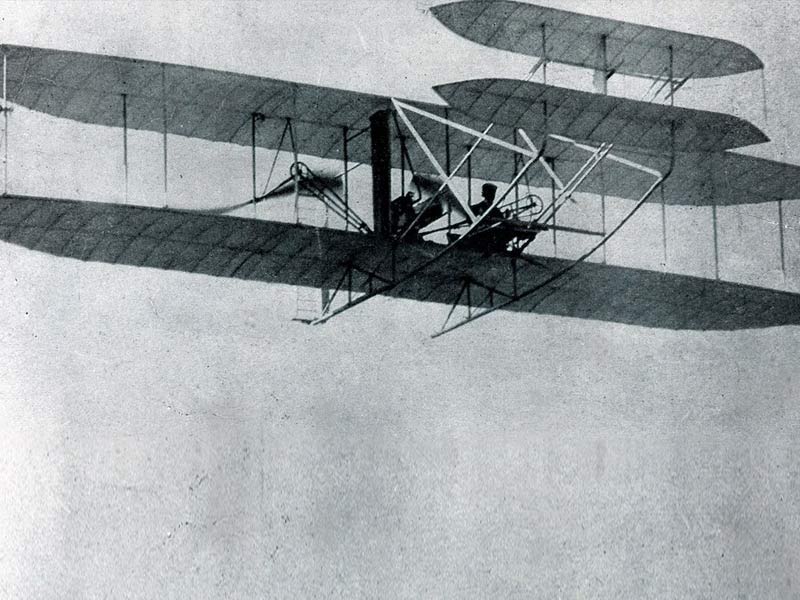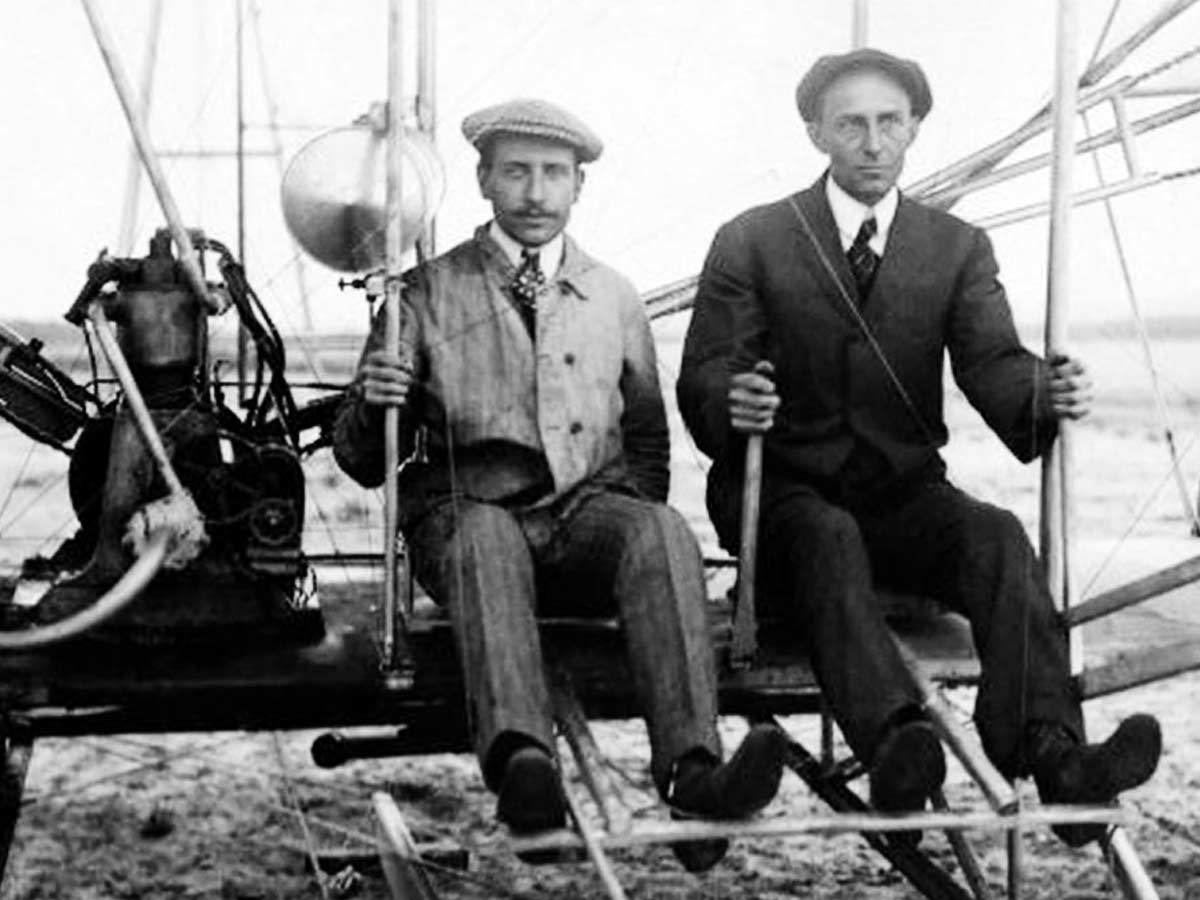The Wright Brothers – Orville was born on 19th August 1871 near Millville, Indiana, and Wilbur was born on 16th April 1867 in Dayton, Ohio. They were two American aviation pioneers who are widely regarded as having invented, built, and flown the world’s the first successful motor-powered airplane. On 17th December 1903, they made the first controlled, sustained flight of a powered, heavier-than-air aircraft with the Wright Flyer, 4 miles (6 kilometers) south of Kitty Hawk, North Carolina. The brothers were also the first to develop airplane controls, which enabled fixed-wing powered flight.
The Wright brothers developed their flying machine in 1904–1905, the Wright Flyer II, to achieve longer-running and more aerodynamic flights, followed by the Wright Flyer III, the first fully practical fixed-wing aircraft. The Wright brothers’ innovation was developing a three-axis control system, which allowed the pilot to effectively direct the aircraft while maintaining its stability.
This approach is still used on all fixed-wing aircraft. Wilbur and Orville concentrated their aeronautical effort from the start on finding a dependable technique of pilot control as the key to addressing the flying problem.
This approach was markedly different from that of other experimenters at the time, who were more concerned with constructing strong engines. The Wrights also acquired more accurate data than anyone else before using a small home-built wind tunnel, allowing them to design more efficient wings and propellers. Their first US patent did not claim the development of a flying vehicle but rather a system of aerodynamic control that altered the surfaces of a flying aircraft.
Early life

Milton Wright, an ordained minister of the Church of the United Brethren in Christ, and Susan Catherine Koerner Wright met while Milton studied for the ministry. Susan was a student at a United Brethren institution in Hartsville, Indiana. Before Wilbur was born, the couple had two boys, Reuchlin (1861–1920) and Lorin (1862–1939), on a farm near Millville. The young family subsequently relocated to Dayton, Ohio, so Milton could work as the editor of a church newspaper. Otis and Ida, twins, were born and died in that city in 1870. Katharine (1874–1929) arrived a year later, followed by Orville.
Also Read, 8 Inventions That Changed The World Forever
Personal Life
Wilbur and Orville were the only Wright brothers who did not go to college or marry. Wilbur’s college dreams were dashed when he was injured in a hockey accident in the winter of 1885–86. He spent the next three years regaining his health, reading extensively in his father’s library, supporting the bishop with legal and church issues, and caring for his sick mother, who died of tuberculosis in 1889.
Early Mechanical Career
Following the death of their mother, Orville, who had spent several summers studying the printing trade, encouraged Wilbur to join him in opening a print business. Along with standard printing services, the brothers edited and published two short-lived local newspapers. They also published The Tattler, a newspaper for Dayton’s African American population, edited by poet Paul Laurence Dunbar, Orville’s high school classmate. They earned a local reputation for the high quality of the presses they designed, constructed, and supplied to other printers. These printing presses were one of the first pieces of evidence of the Wright brothers’ outstanding technical aptitude and their distinct approach to mechanical design issues.

In 1892, the Wright brothers opened a bicycle sales and repair store, and in 1896, they started building bicycles on a modest scale. They created their own self-oiling bicycle wheel hub and outfitted the shop with various light machine machines. Profits from the print shop and the bicycle business were eventually used to fund the Wright brothers’ aeronautical experiments, which lasted from 1899 to 1905. Furthermore, the expertise in designing and producing lightweight, accurate devices out of wood, wire, and metal tubing was excellent preparation for the fabrication of flying vehicles.
Airplane Design
The Wright brothers carefully followed the research of German aviator Otto Lilienthal. He was always working on different mechanical projects and keeping up with scientific studies. When Lilienthal perished in a glider crash, the brothers decided to begin their own flight experiments. Wilbur and Orville traveled to Kitty Hawk, North Carolina, noted for its strong winds, determined to create their own successful design.

Wilbur and Orville got to work figuring out how to design wings for flying. They saw birds angling their wings for balance and control and attempted to imitate this, establishing the concept of “wing warping.” The Wright brothers discovered they had the golden formula when they added an adjustable rudder—on 17th December 1903, they flew the first free, controlled flight of a power-driven, heavier-than-air plane. Wilbur flew their plane for 59 seconds across a distance of 852 feet, an incredible feat.
The Wright brothers quickly discovered that their achievement was not universally admired. Many in the press and fellow flight specialists were skeptical of the brothers’ assertions. As a result, Wilbur set out for Europe in 1908, hoping to succeed in persuading the public and selling planes.
Name and Fame
Wilbur found a considerably more receptive audience in France. He took several public flights and chauffeured officials, journalists, and statesmen. Orville traveled to Europe with his brother in 1909, as did their younger sister Katharine. The Wrights became great superstars in the country, where they were entertained by royals and chiefs of state and were frequently featured in the news. Before returning to the United States in 1909, the Wrights began selling their airplanes throughout Europe. The Wright brothers became successful businessmen after winning aviation contracts in Europe and the United States.
Wilbur and Orville always shared credit for their ideas and remained close throughout their lives. However, there was a division of effort behind the scenes. Wilbur was the operation’s business mind and executive, functioning as president of the Wright corporation with his quick instincts.

Death and Enduring Legacy
Wilbur became unwell while visiting Boston in April 1912. He died on 30th May at his family home in Dayton, Ohio, after being diagnosed with typhoid disease. In his diary, Milton Wright wrote, “A short life, full of repercussions.” He lived and died with an unfailing intellect, a calm temper, immense self-reliance, and as much modesty. He recognized the truth clearly and pursued it relentlessly.





























